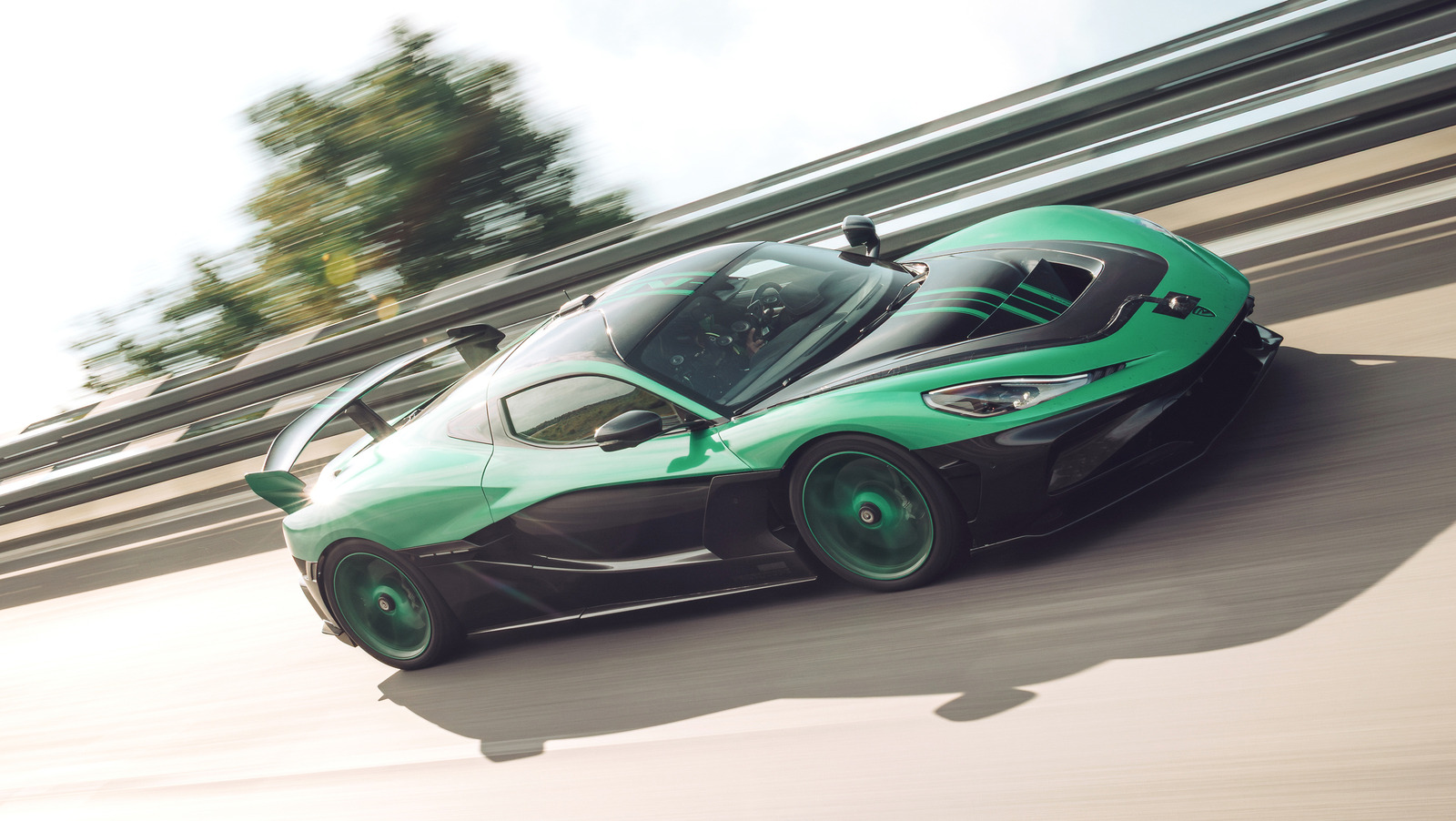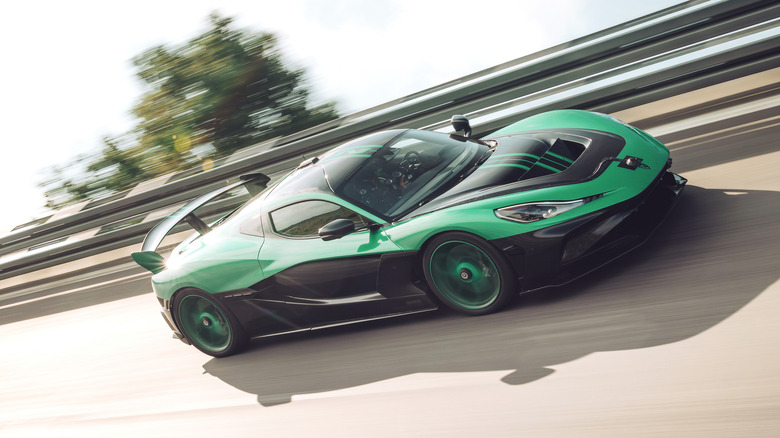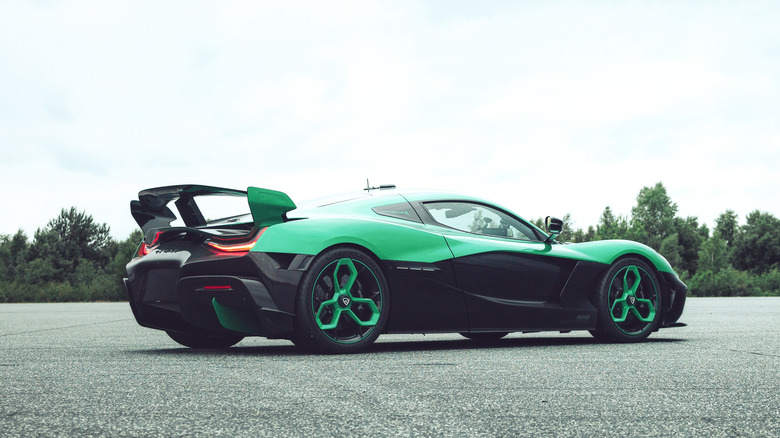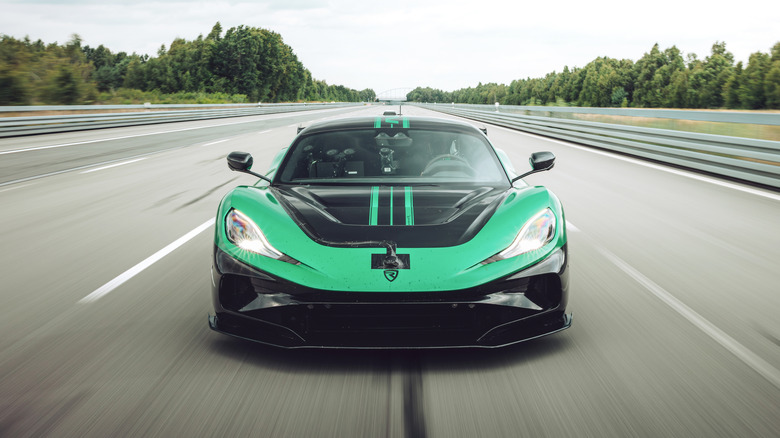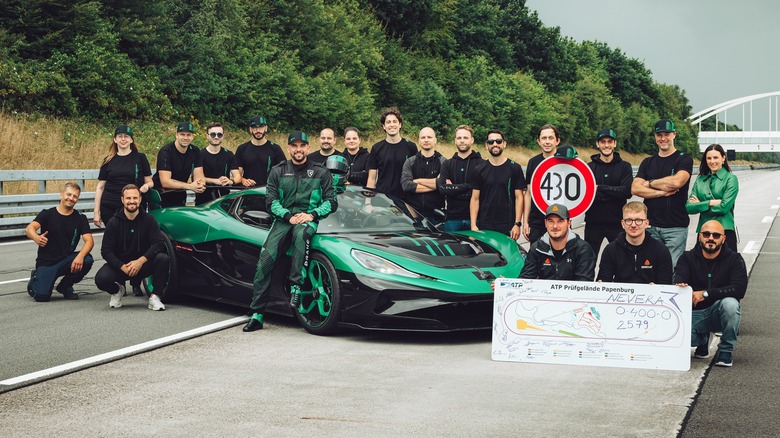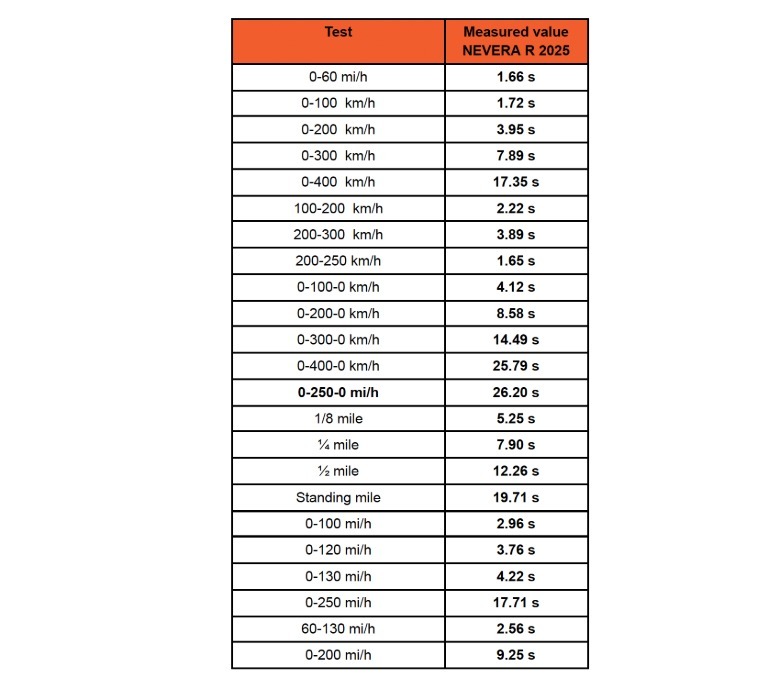Back in 2023 the Rimac Nevera broke 23 performance records in one day, after it had already set the production electric vehicle top speed record. Basically all of those 23 records were about acceleration and braking performance, but the most impressive feat was the Nevera’s time on a run from 0 to 400 kilometers per hour and back to 0 again, or 0-249-0 mph. The Croatian electric hypercar managed the feat in 29.93 seconds, beating the previous record holder, the Koenigsegg Regera, by 1.56 seconds. Koenigsegg took that record back the same year, then last summer it broke the record again with the Jesko, setting a time of 27.83 seconds. (Looking at 0-250-0-mph times instead of just converting from kph and the Jesko still set new benchmarks.)
Enter the Rimac Nevera R, which was first unveiled last year during Monterey Car Week. Rimac says the Nevera R, of which only 40 will be made, is for customers who wanted even more performance and better, more engaging handling. Still, Rimac gave the Nevera R 2,107 horsepower, 193 hp more than the standard Nevera, and if you can believe it the Nevera R is even more neck-breakingly quick. With times independently verified by Dewesoft, the Nevera R set 24 new performance records and took back the 0-250-0-mph crown, but I don’t think that record is what’s really wild here: not only will the Rimac Nevera R hit 100 mph in under 3 seconds, it will run the quarter-mile in less than 8 seconds. Yes, really. It set a new top speed record, too.
It’s extremely quick
These records were set on between July 5 and 8 at the Automotive Testing Papenburg proving ground, and Rimac says it was part of the final validation testing before customer deliveries start. The car was in its high-speed mode for the tests, which as with its Bugatti cousins unlocks the maximum top speed. It wasn’t on some sort special tire, either — just Michelin Cup 2s. The Nevera R’s redesigned exterior and aerodynamic package generates 15% more downforce while also improving aerodynamic efficiency by 10%, and its quad electric motors’ torque vectoring system can calculate and adjust power delivery 100 times per second, per wheel. Now, Rimac says it set 24 records because it measured acceleration times in both kph and mph, for example there’s both a 0-200-kph time (124 mph) and a 0-120-mph time. For most of the below, I am going with the kph times converted, as those are more commonly referenced, but at the bottom of the story I’ve put the whole chart.
Alright, first up are simple acceleration times. Dewesoft’s report says these were measured after 1 foot of rollout was detected with a total velocity threshold of 0.5 mph. An EV as powerful as the Nevera R hits that threshold pretty quickly. 0-60 mph takes an excruciating 1.66 seconds, 0.08 second quicker than the normal Nevera. (0-100 kph, or 0-62 mph, took 1.72 seconds.) 0-100 mph is dispatched in 2.96 seconds, a quarter-second improvement and quicker than a Porsche Taycan GTS hits 60 mph. The Nevera R needs 3.95 seconds to hit 124 mph (a 0.47-second improvement), 186 mph arrives in 7.89 seconds (a 1.33-second improvement), and reaching 200 mph takes 9.25 seconds (a 1.61-second improvement). The Nevera R reaches 249 mph in 17.35 seconds, an entire 3.96 seconds quicker than the standard car and a couple seconds before the Koenigsegg Jesko reaches that mark.
The Nevera R is also the first production car to put down a quarter-mile time under 8 seconds, doing it in 7.90 seconds. Now, the basic Nevera already would run the quarter-mile in 8.25 seconds, but still, my god. It only needs 19.71 seconds to dispatch the standing mile, too, almost a second quicker.
It also stops extremely quickly
How about stopping? The headline number here is the 0-400-0-kph time, which works out to 249 mph. The Nevera R accomplished the feat in 25.79 seconds, 4.14 seconds quicker than the standard Nevera and 2.04 seconds quicker than the Jesko attack. If you want to get mph-specific with a round number, Rimac’s measured 0-250-0-mph time is 26.2 seconds, beating the old car by 5.21 seconds and besting the Jesko by 2.07 seconds.
If running just from 0 to 60 mph and back to 0 again, the Nevera R needs just 3.32 seconds. It can hit 124 mph and be back at 0 in 8.58 seconds, and it’ll do 0-186-0 mph in 14.49 seconds, more than a second quicker than the normal Nevera. Rimac hasn’t said how powerful the Nevera R’s regenerative brakes are; the standard Nevera can decelerate at 0.4 g with 300 kW of recuperation, which is quite substantial, but the Nevera R also has new, larger Evo2 carbon-ceramic brakes with a silicone matrix layer.
It’s extremely fast, too
Oh yeah, and the Nevera R’s top speed is higher. Dewesoft certified it at 268.092 mph, with an average velocity of exactly 268 mph over 600 meters traveled. The company says the speed was measured with an accuracy of 0.054 kph, so you know it’s legit. That means the Nevera R tops out 12 mph higher than the standard Nevera, which had set the EV top speed record in 2022. It’s also a tick better than what the Bugatti Veyron Super Sport managed. Rimac hasn’t yet said if it has tested the Nevera R in reverse, but hopefully it tops the Nevera’s 171-mph top speed when backing up.
The Nevera is a beast at the Nürburgring, having set the electric production car record in 2023 with a time of 7:05.298, but that was surpassed by a few tenths of a second earlier this year by the Xiaomi SU7 Ultra. (The Chinese phone-company-turned-automaker has since put down a time faster than any production car with a prototype version of its sedan, but it remains to be seen what elements will make it to production.) The Nevera also set a production car hillclimb record at the 2023 Goodwood Festival of Speed by running up that hill in 49.32 seconds, but the Czinger 21C beat it by about a second and a half last year
Rimac says “there’s plenty more opportunity for Nevera R to now hunt down those remaining records and more.” The company will be at this year’s running of the Goodwood Festival of Speed this weekend with the Nevera R, so don’t be surprised to see that record get taken back. Regarding the Nevera R in general, Rimac says that once again it “has proven that its engineering and design talent is among the best in the world, able to push the limits of performance to create the fastest accelerating production car the world has ever seen — electric or otherwise.”


